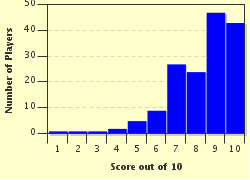Quiz Answer Key and Fun Facts
1. Spelt, einkorn, and common are three of the best-known varieties of this dark cereal grain that originated in the Middle East.
2. As a flour it is a staple of Mexican foods, but corn is a cultivar dramatically different from its original form known as this.
3. Once milled and eaten by many ancient peoples, in modern times this seed's flour is used mainly in Korean foods like dotorimuk.
4. This misleadingly-titled grain is named after its seeds. Its biggest output comes from Russia, and it can be used for blintzes and knishes.
5. To avoid poisoned tapioca starch/flour, this root must be carefully prepared and leeched of cyanides.
6. Commonly eaten whole or as 'butter', this seed is also used to make flour. George Washington Carver helped popularize it in the early 20th century.
7. Though commonly fried into slices or chips, bread and biscuits can be made from the flour of this tuber.
8. Pumpernickel is one of the breads made from the flour of this plant, which is hardy but susceptible to ergot.
9. The 'krispy' nature of this flour leads to its use in some candies. Its flour is also used to make noodles and even sake.
10. One of the oldest of all cereal grains, flour from this grass is used in porridge and gruel in Europe, and tsampa in Tibet.
Source: Author
nautilator
This quiz was reviewed by FunTrivia editor
WesleyCrusher before going online.
Any errors found in FunTrivia content are routinely corrected through our feedback system.


